Insights into the Correlation between Residual Stresses, Phase Transformation, and Wettability of Femtosecond Laser-Irradiated Ductile Iron
Abstract
1. Introduction
2. Materials and Methods
3. Results and Discussions
3.1. Residual Stress and Micrograph Analysis
3.2. Phase Transformation of the Near-Surface Layer
3.3. TEM Characterization
3.4. Wettability Analysis
4. Conclusions
Supplementary Materials
Author Contributions
Funding
Institutional Review Board Statement
Informed Consent Statement
Data Availability Statement
Acknowledgments
Conflicts of Interest
References
- Sugioka, K.; Cheng, Y. Ultrafast lasers—Reliable tools for advanced materials processing. Light Sci. Appl. 2014, 3, e149. [Google Scholar] [CrossRef]
- Cubero, Á.; Martínez, E.; Angurel, L.A.; de la Fuente, G.F.; Navarro, R.; Legall, H.; Krüger, J.; Bonse, J. Surface Superconductivity Changes of Niobium Sheets by Femtosecond Laser-Induced Periodic Nanostructures. Nanomaterials 2020, 10, 2525. [Google Scholar] [CrossRef] [PubMed]
- Zaum, C.; Osterloh, N.; Darkins, R.; Duffy, D.M.; Morgenstern, K. Real-space observation of surface structuring induced by ultra-fast-laser illumination far below the melting threshold. Sci. Rep. 2021, 11, 13269. [Google Scholar] [CrossRef] [PubMed]
- Vlahou, M.; Fraggelakis, F.; Manganas, P.; Tsibidis, G.D.; Ranella, A.; Stratakis, E. Fabrication of Biomimetic 2D Nanostructures through Irradiation of Stainless Steel Surfaces with Double Femtosecond Pulses. Nanomaterials 2022, 12, 623. [Google Scholar] [CrossRef]
- Ionin, A.A.; Kudryashov, S.I.; Seleznev, L.V.; Sinitsyn, D.V.; Bunkin, A.F.; Lednev, V.N.; Pershin, S.M. Thermal melting and ablation of silicon by femtosecond laser radiation. J. Exp. Theor. Phys. 2013, 116, 347–362. [Google Scholar] [CrossRef]
- Ionin, A.A.; Kudryashov, S.I.; Seleznev, L.V.; Sinitsyn, D.V. Generation and detection of superstrong shock waves during ablation of an aluminum surface by intense femtosecond laser pulses. J. Exp. Theor. Phys. Lett. 2011, 94, 753–758. [Google Scholar] [CrossRef]
- Smith, M.J.; Sehr, M.; Franta, B.; Lin, Y.; Mazur, E.; Gradecak, S. The origins of pressure-induced phase transformations during the surface texturing of silicon using femtosecond laser irradiation. J. Appl. Phys. 2012, 112, 083518. [Google Scholar] [CrossRef]
- Dehoux, T.; Wright, O.B.; LiVoti, R. Picosecond time scale imaging of mechanical contacts. Ultrasonics 2010, 50, 197–201. [Google Scholar] [CrossRef][Green Version]
- Tomoda, M.; Matsuda, O.; Wright, O.B. Tomographic reconstruction of picosecond acoustic strain propagation. Appl. Phys. Lett. 2006, 90, 041114. [Google Scholar] [CrossRef]
- Liu, D.; Shi, Y.; Liu, J.; Wen, L. Effect of laser shock peening on corrosion resistance of 316L stainless steel laser welded joint. Surf. Coat. Technol. 2019, 378, 124824. [Google Scholar] [CrossRef]
- Yang, J.M.; Her, Y.C.; Han, N.; Clauer, A. Laser shock peening on fatigue behavior of 2024-T3 Al alloy with fastener holes and stopholes. Mater. Sci. Eng. A 2001, 298, 296–299. [Google Scholar] [CrossRef]
- Smith, M.J.; Lin, Y.T.; Sher, M.J.; Winkler, M.T.; Mazur, E.; Gradecak, S. Pressure-induced phase transformations during femtosecond-laser doping of silicon. J. Appl. Phys. 2011, 110, 053524. [Google Scholar] [CrossRef]
- Kietzig, A.M.; Hatzikiriakos, S.G.; Englezos, P. Patterned superhydrophobic metallic surfaces. Langmuir 2009, 25, 4821–4827. [Google Scholar] [CrossRef]
- Nakhoul, A.; Rudenko, A.; Sedao, X.; Peillon, N.; Colombier, J.P.; Maurice, C.; Blanc, G.; Borbély, A.; Faure, N.; Kermouche, G. Energy feedthrough and microstructure evolution during direct laser peening of aluminum in femtosecond and picosecond regimes. J. Appl. Phys. 2021, 130, 015104. [Google Scholar] [CrossRef]
- Kumar, D.; Liedl, G.; Gururaja, S. Formation of sub-wavelength laser induced periodic surface structure and wettability transformation of CFRP laminates using ultra-fast laser. Mater. Lett. 2020, 276, 128282. [Google Scholar] [CrossRef]
- Ghassemali, E.; Hernando, J.C.; Stefanescu, D.M.; Dioszegi, A.; Jarfors, A.E.W.; Dluhoš, J.; Petrenec, M. Revisiting the graphite nodule in ductile iron. Scr. Mater. 2019, 161, 66–69. [Google Scholar] [CrossRef]
- Azeem, M.A.; Bjerre, M.K.; Atwood, R.C.; Tiedje, N.; Lee, P.D. Synchrotron quantification of graphite nodule evolution during the solidification of cast iron. Acta Mater. 2018, 155, 393–401. [Google Scholar] [CrossRef]
- Zhidkov, M.V.; Vershinin, T.N.; Golosova, O.A.; Kudryashov, S.I.; Ionin, A.A. Surface texturing of steel by femtosecond laser and accompanying structure/phase transformations. Opt. Laser Technol. 2020, 131, 106370. [Google Scholar] [CrossRef]
- Kumar, D.; Sauer, M.; Ching, K.K.; Kalss, G.; Santos, A.C.V.D.d.; Ramer, G.; Foelske, A.; Lendl, B.; Liedl, G.; Otto, A. Wettability transition of femtosecond laser patterned nodular cast iron (NCI) substrate. Appl. Surf. Sci. 2021, 559, 149897. [Google Scholar] [CrossRef]
- Vargaftik, N.B.; Volkov, B.N.; Voljak, L.D. International Tables of the Surface Tension of Water. J. Phys. Chem. Ref. Data 1983, 12, 817–820. [Google Scholar] [CrossRef]
- Kozbial, A.; Li, Z.; Conaway, C.; McGinley, R.; Dhingra, S.; Vahdat, V.; Zhou, F.; D’Urso, B.; Liu, H.; Li, L. Study on the surface energy of graphene by contact angle measurements. Langmuir 2014, 30, 8598–8606. [Google Scholar] [CrossRef] [PubMed]
- Wang, J.; Wu, Y.; Cao, Y.; Li, G.; Liao, Y. Influence of surface roughness on contact angle hysteresis and spreading work. Colloid Polym. Sci. 2020, 298, 1107–1112. [Google Scholar] [CrossRef]
- Bell, M.S.; Shahraz, A.; Fichthorn, K.A.; Borhan, A. Effects of hierarchical surface roughness on droplet contact angle. Langmuir 2015, 31, 6752–6762. [Google Scholar] [CrossRef] [PubMed]
- Behera, S.K.; Ajay, K.P.; Dogra, N.; Nosonovsky, M.; Rohatgi, P. Effect of microstructure on contact angle and corrosion of ductile iron: Iron-graphite composite. Langmuir 2019, 35, 16120–16129. [Google Scholar] [CrossRef] [PubMed]
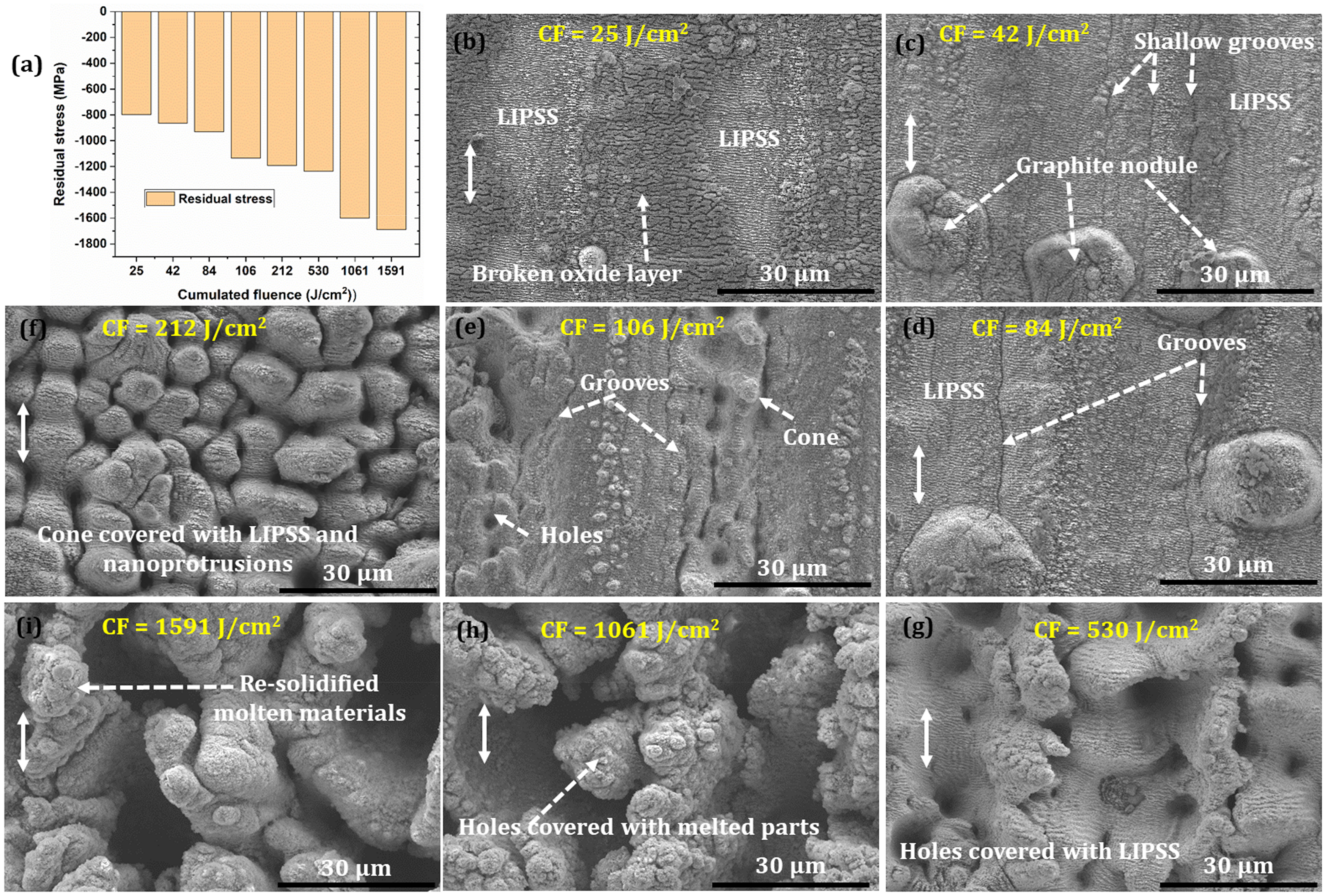
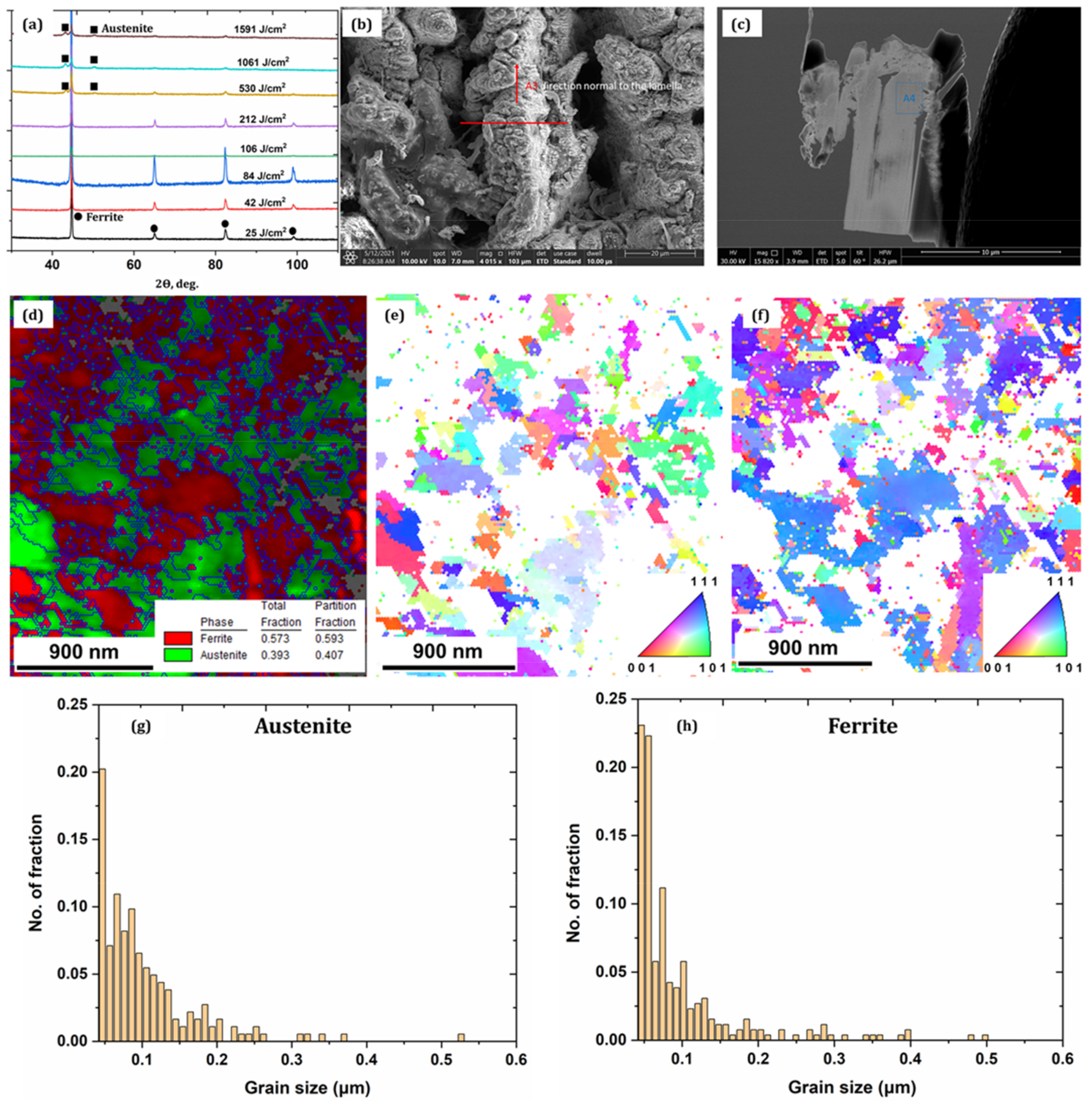
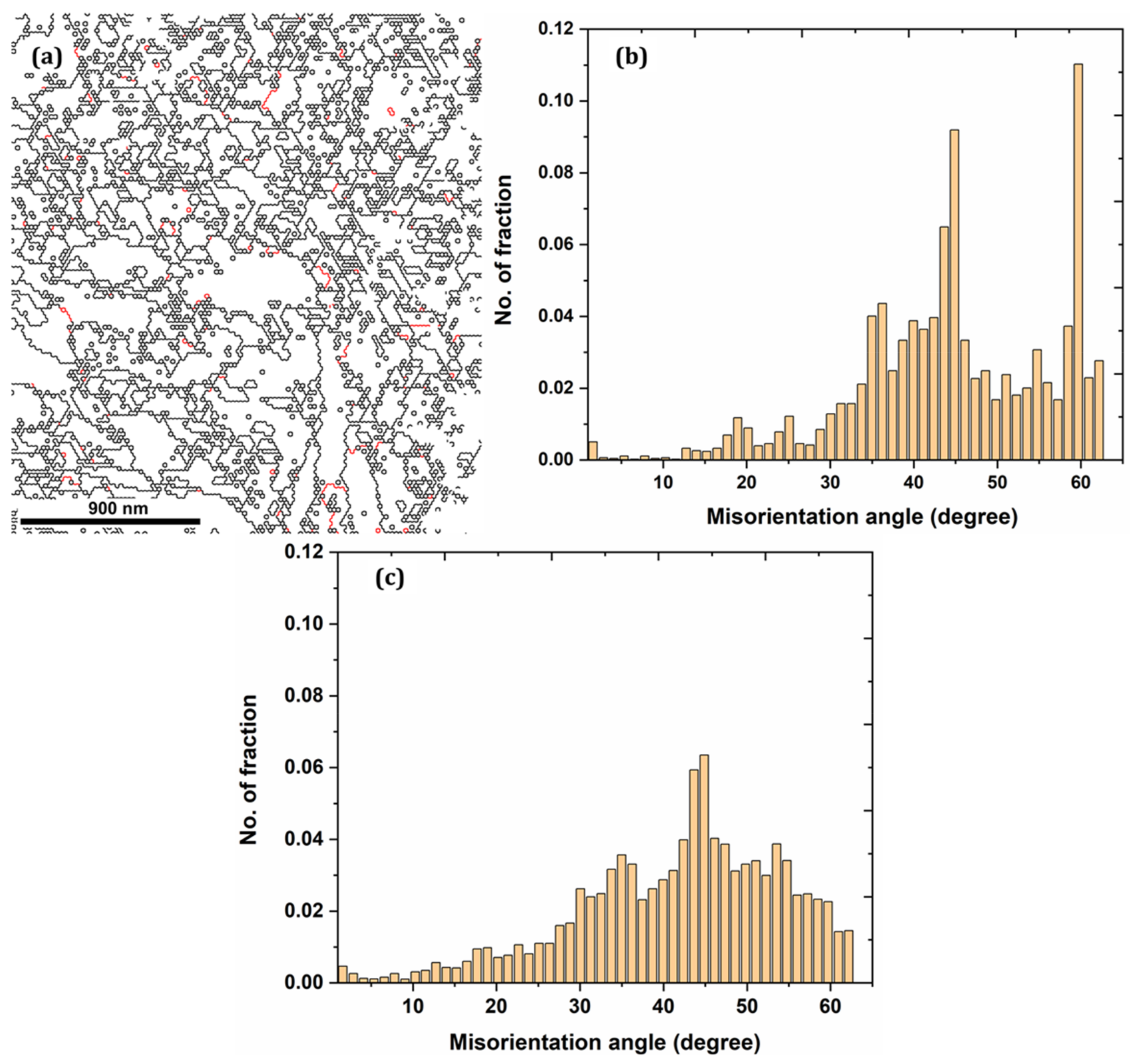
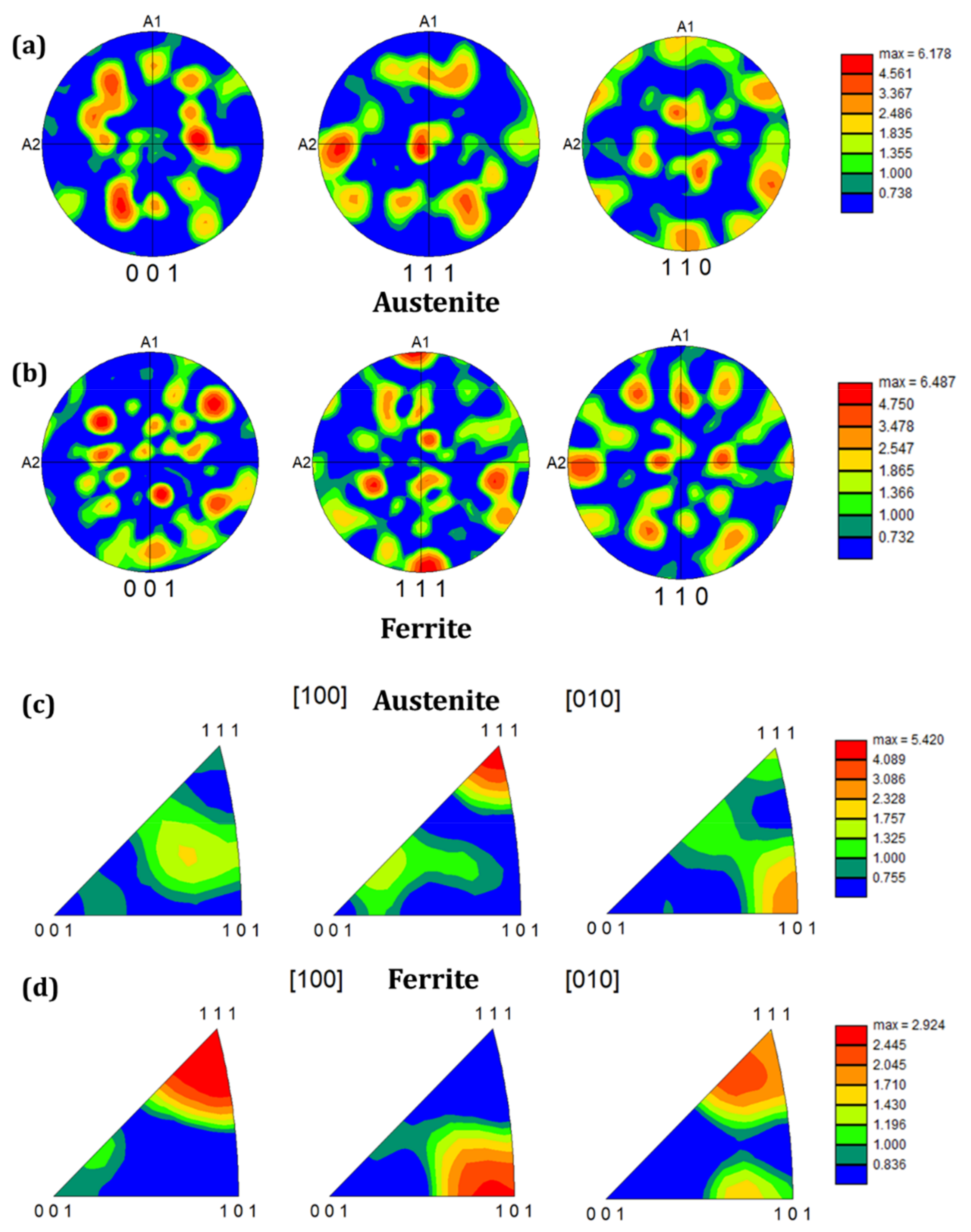


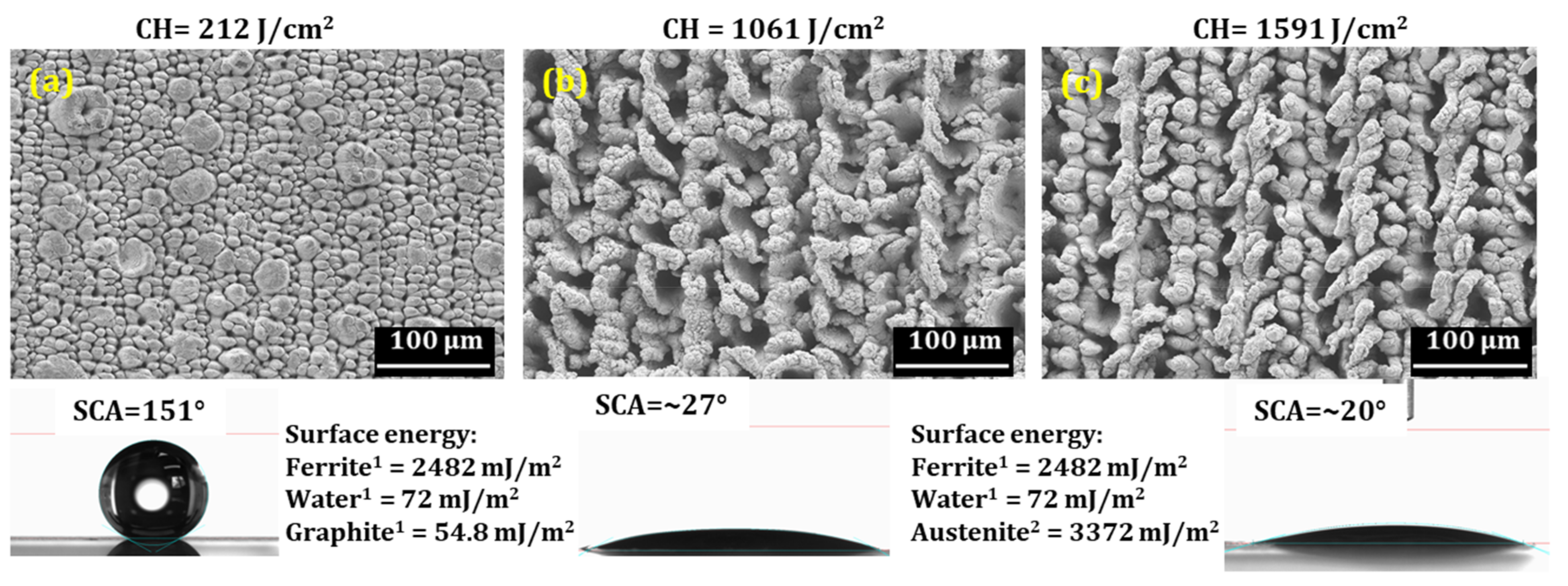
Publisher’s Note: MDPI stays neutral with regard to jurisdictional claims in published maps and institutional affiliations. |
© 2022 by the authors. Licensee MDPI, Basel, Switzerland. This article is an open access article distributed under the terms and conditions of the Creative Commons Attribution (CC BY) license (https://creativecommons.org/licenses/by/4.0/).
Share and Cite
Kumar, D.; Liedl, G.; Otto, A.; Artner, W. Insights into the Correlation between Residual Stresses, Phase Transformation, and Wettability of Femtosecond Laser-Irradiated Ductile Iron. Nanomaterials 2022, 12, 1271. https://doi.org/10.3390/nano12081271
Kumar D, Liedl G, Otto A, Artner W. Insights into the Correlation between Residual Stresses, Phase Transformation, and Wettability of Femtosecond Laser-Irradiated Ductile Iron. Nanomaterials. 2022; 12(8):1271. https://doi.org/10.3390/nano12081271
Chicago/Turabian StyleKumar, Dhiraj, Gerhard Liedl, Andreas Otto, and Werner Artner. 2022. "Insights into the Correlation between Residual Stresses, Phase Transformation, and Wettability of Femtosecond Laser-Irradiated Ductile Iron" Nanomaterials 12, no. 8: 1271. https://doi.org/10.3390/nano12081271
APA StyleKumar, D., Liedl, G., Otto, A., & Artner, W. (2022). Insights into the Correlation between Residual Stresses, Phase Transformation, and Wettability of Femtosecond Laser-Irradiated Ductile Iron. Nanomaterials, 12(8), 1271. https://doi.org/10.3390/nano12081271






